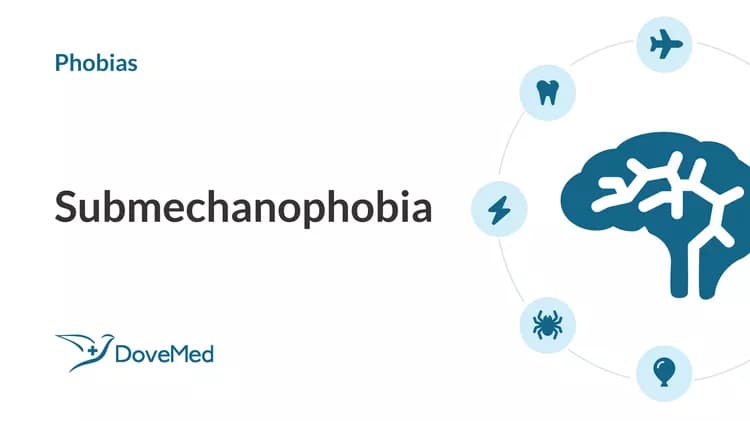What are the other Names for this Condition? (Also known as/Synonyms)
- Fear of Submerged Human-Made Objects
- Fear of Submerged Man-Made Objects
What is Submechanophobia? (Definition/Background Information)
- Submechanophobia is a specific phobia that involves an excessive, irrational, and persistent fear of submerged man-made objects, such as sunken ships, airplanes, and underwater machinery.
- Anyone can develop Submechanophobia, but it is more common in people who have had traumatic experiences involving water or submerged objects. It can also be more prevalent in individuals with other anxiety disorders.
- Submechanophobia can be caused by various factors, including traumatic experiences, learned behaviors, and genetic predisposition.
- Risk factors include a history of traumatic experiences, family history of anxiety disorders, and exposure to media or real-life situations involving submerged objects.
- Symptoms may include intense anxiety or panic, avoidance of water-related activities or locations, physical symptoms such as sweating, shaking, or a racing heart, and intrusive thoughts or nightmares.
- Submechanophobia can be diagnosed through a comprehensive evaluation by a mental health professional, who will assess the individual's symptoms, history, and potential risk factors.
- Treatment may include cognitive-behavioral therapy (CBT), exposure therapy, or medication, depending on the severity of the phobia and the individual's specific needs and preferences.
- Coping strategies may include deep breathing, mindfulness techniques, avoiding triggers, or gradually exposing oneself to submerged objects in a safe and controlled environment.
- Complications of Submechanophobia can include interference with daily activities, social isolation, and increased risk of other mental health conditions such as depression and anxiety disorders.
- With appropriate treatment and support, many people can learn to manage and overcome their fears and lead fulfilling lives.
Who gets Submechanophobia? (Age and Sex Distribution)
- Submechanophobia can affect anyone, regardless of age, gender, or ethnicity.
- It may develop in childhood or adulthood, and individuals with a history of anxiety or phobias may be more susceptible to developing Submechanophobia.
What are the Risk Factors for Submechanophobia? (Predisposing Factors)
Some of the risk factors for Submechanophobia may include:
- Having a family history of anxiety or phobias
- Having experienced a traumatic event involving water or submerged objects
- Having a general fear of water or swimming
- Being exposed to media or entertainment that depicts submerged machinery or vehicles in a negative or frightening way
It is important to note that having a risk factor does not mean that one will get the condition. A risk factor increases one’s chances of getting a condition compared to an individual without the risk factors. Some risk factors are more important than others.
Also, not having a risk factor does not mean that an individual will not get the condition. It is always important to discuss the effect of risk factors with your healthcare provider.
What are the Causes of Submechanophobia? (Etiology)
- The exact cause of Submechanophobia is unknown, but it may be related to traumatic experiences or negative associations with water or submerged objects.
- It may also be related to a fear of the unknown or fear of losing control.
What are the Signs and Symptoms of Submechanophobia?
The signs and symptoms of Submechanophobia may include:
- Intense fear or anxiety in the presence of submerged man-made objects
- Avoidance of activities or places that involve submerged objects or water
- Panic attacks or feelings of terror when encountering submerged objects
- Physical symptoms such as sweating, trembling, or nausea
- Difficulty sleeping or nightmares related to submerged objects
How is Submechanophobia Diagnosed?
- Submechanophobia can be diagnosed by a mental health professional through a thorough evaluation of symptoms and medical history.
- They may also use standardized questionnaires or assessments to measure the severity of the fear and its impact on daily life.
Many clinical conditions may have similar signs and symptoms. Your healthcare provider may perform additional tests to rule out other clinical conditions to arrive at a definitive diagnosis.
What are the possible Complications of Submechanophobia?
- Untreated Submechanophobia can lead to significant impairment in daily life and may cause individuals to avoid activities or situations that involve water or submerged objects.
- This can lead to social isolation, decreased quality of life, and even depression or other mental health conditions.
How is Submechanophobia Treated?
There are several treatment options for Submechanophobia, including:
- Cognitive-behavioral therapy (CBT): a type of talk therapy that helps individuals identify and challenge negative thoughts and beliefs about submerged objects, and gradually confront them in a safe and controlled manner.
- Exposure therapy: a form of CBT that involves gradually exposing individuals to submerged objects in a safe and controlled environment to help them overcome their fear.
- Medications: in some cases, medications such as anti-anxiety medications or beta-blockers may be prescribed to help manage symptoms.
- Relaxation techniques: practicing relaxation techniques such as deep breathing, progressive muscle relaxation, or meditation may help reduce anxiety and improve coping skills.
How can Submechanophobia be Prevented?
While there is no guaranteed way to prevent Submechanophobia, some strategies that may help include:
- Exposing children to water and submerged objects in a safe and controlled environment to help build familiarity and comfort
- Encouraging positive associations with water and submerged objects through fun activities such as swimming, snorkeling, or diving
- Limiting exposure to media or entertainment that depicts submerged objects in a negative or frightening way
What is the Prognosis of Submechanophobia? (Outcomes/Resolutions)
- With proper treatment and support, many individuals with Submechanophobia can overcome their fear and improve their quality of life.
- However, recovery may take time and may involve setbacks, particularly if the fear has been present for a long time.
Additional and Relevant Useful Information for Submechanophobia:
The following link is a useful resource for information on other mental health conditions on DoveMed:
https://www.dovemed.com/healthy-living/emotional-well-being/
Related Articles
Test Your Knowledge
Asked by users
Related Centers
Related Specialties
Related Physicians
Related Procedures
Related Resources
Join DoveHubs
and connect with fellow professionals


0 Comments
Please log in to post a comment.